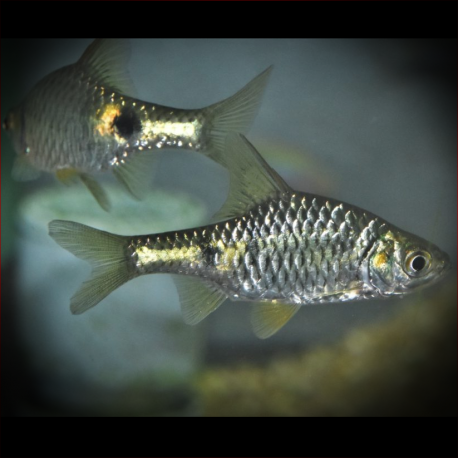More info
Datasheet
| Minimum Tank Size | 72 litres / 19.02 US gallons |
| Maximum Size | 9.0cm / 3.54inches |
| Temperature | 18°C / 64.40°F - 26°C / 78.80°F |
| Hardness | 2.02dgH / 36ppm - 12.05dgH / 215ppm |
| pH | 6.5-7.5 |
General Description
The Onespot Barb, scientifically known as Puntius Terio, is an uncommon species in the aquarium trade despite its extensive natural range. Variations in color patterns exist among different populations, but all share common markings such as a yellow-gold spot on the operculum and a dark spot on the caudal peduncle. This species was previously classified under the genus Puntius until taxonomic revisions led to the creation of new genera like Dawkinsia and Haludaria. Adult Onespot Barbs typically measure less than 120mm SL and exhibit specific anatomical features, including a blackish spot on the caudal peduncle.
Aquarium Setup
To maintain Onespot Barbs in captivity, a minimum tank size of 72 litres is recommended. Setting up the aquarium involves providing a substrate of sand or gravel, along with water-worn rocks, driftwood, and plants like Microsorum or Anubias spp. Lighting can be kept subdued, recreating a natural habitat for these fish. Water parameters should ideally be maintained within a pH range of 6.5-7.5, a temperature between 18-26°C, and a hardness of 36-215ppm (see table for details).
Behaviour
Known for their peaceful nature, Onespot Barbs thrive in community aquariums and can coexist with various popular fish species. They are schooling fish by nature and should ideally be kept in groups of at least 8-10 individuals. Maintaining them in decent numbers reduces stress, enhances color display in males during courtship, and creates a more natural aesthetic for observers.
Feeding and Diet
Onespot Barbs are likely foraging omnivores consuming worms, insects, plant material, and organic detritus in their natural habitat. In aquariums, they readily accept a diet of small live and frozen foods like bloodworms, Daphnia, and Artemia. Supplementing their diet with high-quality dried flakes and granules enriched with plant or algal content ensures their nutritional needs are met.
Reproduction & Dimorphism
Information regarding the specific reproduction habits of Onespot Barbs is currently unrecorded. However, adult males exhibit slight size differences, enhanced coloration, and more extensive yellow-gold pigmentation on the caudal peduncle compared to females. These features intensify during the mating season in well-conditioned males.
Habitat and Distribution
The Onespot Barb is widely distributed across regions including Pakistan, northern India, Nepal, and Bangladesh, inhabiting small streams, rivers, and periodically inundated zones. These fish show a preference for calmer waters with muddy or silty substrates. Although primarily found in the Indus, Ganges, and Brahmaputra river drainages, there are sporadic reports of their presence in other areas such as Hyderabad, Andhra Pradesh.

